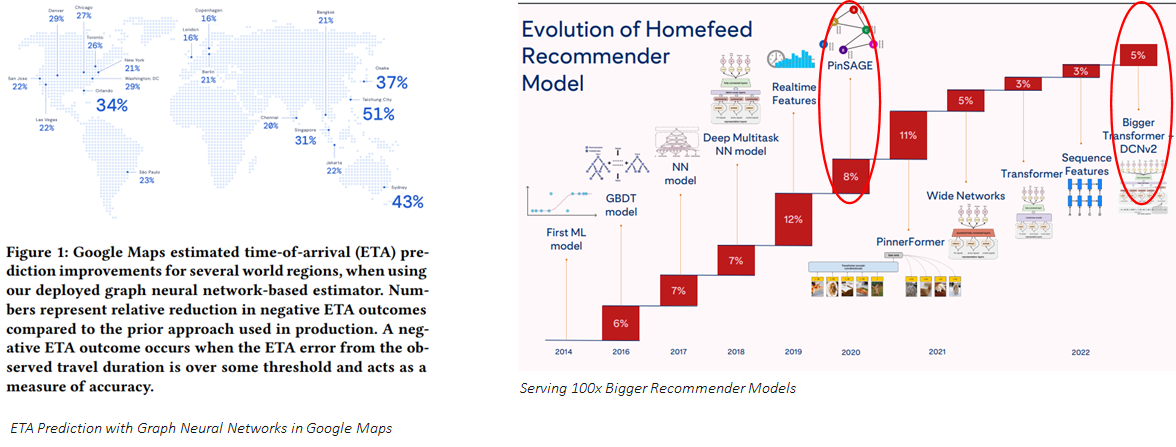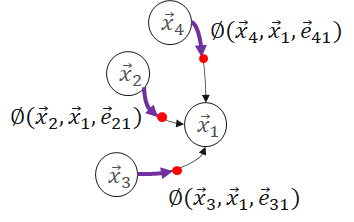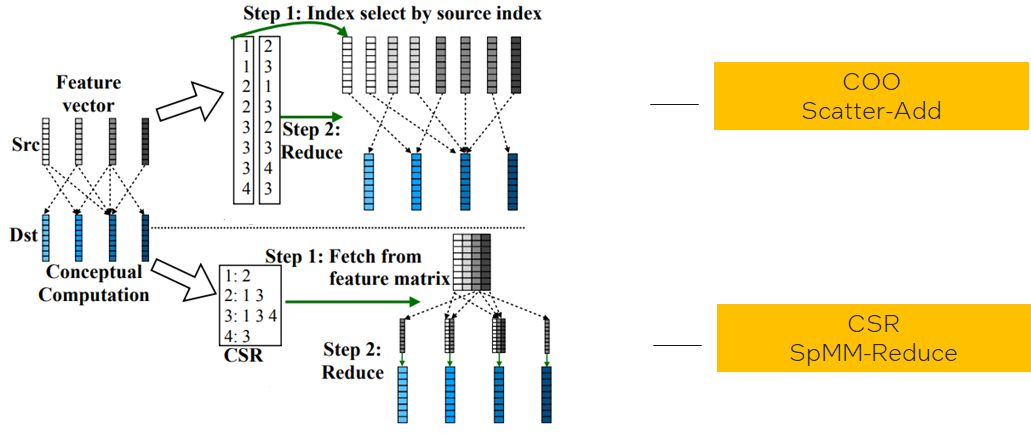图智能 101
GNN 101
Why
Graph无处不在

Graph Intelligence helps

It’s the right time now!
Gartner预测,graph技术在数据和分析创新中的使用率从2021年的10%,到2025年会增长到80%。我们目前正在经历从early adoption到early mainstream的穿越大峡谷期间,既不太早也不太晚,时间刚刚好。

What
如何建模图
A graph 𝒢 is an ordered pair 𝒢 = (𝑉, 𝐸) comprising:
𝑉, a set of vertices (or nodes)
𝐸⊆{(𝑥,𝑦)|𝑥,𝑦∈𝑉}, a set of edges (or links), which are pairs of nodes
Example:
Different Types of Graph
-
Are edges directed?
Directed Graph vs. Undirected Graph -
Are there multiple types of nodes or multiple types of edges?
Homogeneous Graph vs Heterogeneous Graph
如何表示图
不同的表示方式会指向不同的计算模式。

如何计算图
如下图所示,图的计算步骤如下:
-
遍历图中的所有结点,或者采样图中的一些结点。每次选择其中一个结点,称为目标结点(target node);
-
一个𝐿-层的GNN至少需要聚合目标结点的L-跳领域的信息。因此,我们需要以围绕目标结点构造一个L-跳的ego network。图中是一个2-跳ego network的例子,其中绿色结点是第1跳,蓝色结点是第2跳;
-
计算并更新ego-network里的每个结点的embedding。embeddings会使用到图的结构信息和结点与边的特征。

那么,这些embedding是如何计算和更新的呢?主要是使用Message Passing的计算方法。Message Passing有一些计算范式如GAS(Gather-ApplyEdge-Scatter), SAGA(Scatter-ApplyEdge-Gather-ApplyVertex)等。我们这里介绍归纳得比较全面的SAGA计算范式。假设需要计算和更新下图中的 :
:

-
Scatter
Propagate message from source vertex to edge.

-
ApplyEdge
Transform message along each edge.

-
Gather
Gather transformed message to the destination vertex.

-
ApplyVertex
Transform the gathered output to get updated vertex.

公式如下:

分析一下,会发现,SAGA模式中ApplyEdge和ApplyVertex是传统deep learning中的NN(Neural Network)操作,我们可以复用;而Scatter和Gather是GNN新引入的操作。即,Graph Computing = Graph Ops + NN Ops。

不同的图数据集规模
-
One big graph
可能高达数十亿的结点,数百亿的边。

-
Many small graphs

不同的图任务
-
Node-level prediction
预测图中结点的类别或性质

-
Edge-level prediction
预测图中两个结点是否存在边,以及边的类别或性质

-
Graph-level prediction
预测整图或子图的类别或性质

How
Workflow

以fraud detection为例:
Tabformer数据集
workflow
软件栈

-
计算平面

-
数据平面

SW Challenges
Graph Sampler
For many small graphs datasets, full batch training works most time. Full batch training means we can do training on whole graph;
When it comes to one large graph datasets, in many real scenarios, we meet Neighbor Explosion problem;
Neighbor Explosion:
Graph sampler comes to rescue. Only sample a fraction of target nodes, and furthermore, for each target node, we sample a sub-graph of its ego-network for training. This is called mini-batch training.
Graph sampling is triggered for each data loading. And the hops of the sampled graph equals the GNN layer number 𝐿. Which means graph sampler in data loader is important in GNN training.

Challenge: How to optimize sampler both as standalone and in training pipe?
When graph comes to huge(billions of nodes, tens of billions of edges), we meet new at-scale challenges:
-
How to store the huge graph across node? -> graph partition
-
How to build a training system w/ not only distributed model computing but also distributed graph store and sampling?
-
How to cut the graph while minimize cross partition connections?
-

A possible GNN distributed training architecture:

Scatter-Gather
-
Fuse adjacent graphs ops
One common fuse pattern for GCN & GraphSAGE:

Challenge:
How to fuse more GNN patterns on different ApplyEdge and ApplyVertex,automatically? -
How to implement fused Aggregate

Challenge:-
Different graph data structures lead to different implementations in same logic operations;
-
Different graph characteristics favors different data structures;(like low-degree graphs favor COO, high-degree graphs favor CSR)
-
How to find the applicable zone for each and hide such complexity to data scientists?
-
More
-
Inference challenge
-
GNN inference needs full batch inference, how to make it efficient?
-
Distributed inference for big graph?
-
Vector quantization for node and edge features?
-
GNN distilled to MLP?
-
-
SW-HW co-design challenge
-
How to relief irregular memory access in scatter-gather?
-
Do we need some data flow engine for acceleration?
-
-
…
Finishing words
“There is plenty of room at the top” 对技术人员很重要。但为避免入宝山而空返,我们更需要建立起技术架构,这就像是地图一样,只有按图索骥才能更好地探索和利用好top里的plenty of room。

References
-
Graph + AI: What’s Next? Progress in Democratizing Graph for All
-
Recent Advances in Efficient and Scalable Graph Neural Networks
-
Understanding and Bridging the Gaps in Current GNN Performance Optimizations
-
Understanding GNN Computational Graph: A Coordinated Computation, IO, And Memory Perspective
-
fuseGNN: Accelerating Graph Convolutional Neural Network Training on GPGPU
-
VQ-GNN: A Universal Framework to Scale up Graph Neural Networks using Vector Quantization
-
NeuGraph: Parallel Deep Neural Network Computation on Large Graphs
-
Completing a member knowledge graph with Graph Neural Networks
-
PinnerFormer: Sequence Modeling for User Representation at Pinterest







